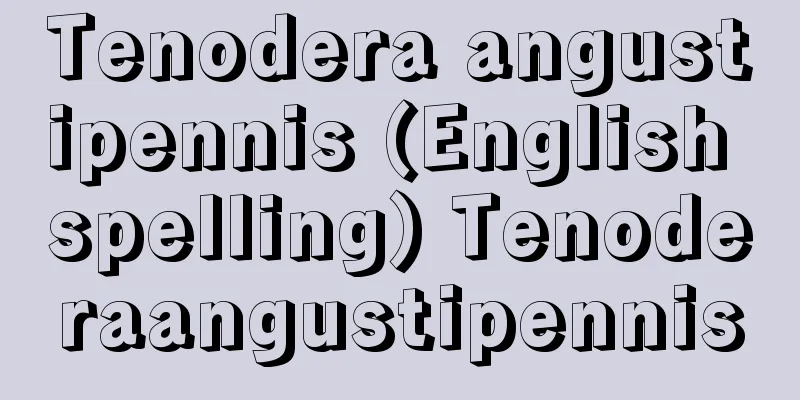Genre - genre (English) genre French

|
It refers to each individual art as a division of art, and the subdivision or type of each individual art. Although it is a concept that spans two levels, the higher-level concept of genre, which refers to individual arts such as literature, music, and painting as art genres, is based on the collective concept of art, and has existed since the late 18th century when this concept of genre was established. At the same time, the lower-level concept of genre has also been generalized to all arts, and has come to be applied to paintings (historical paintings, portraits, genre paintings, landscapes, still lifes, etc.), music (vocal music, instrumental music, etc.), and others, but the original concept of genre is literary. Examples include poetry, plays, novels, and, even further down, epic poetry and lyric poetry as poetic genres. The idea of distinguishing types of literature is classical and standard, as categorized in Aristotle's Poetics from the three perspectives of medium, subject, and mode, but Cicero was the first to use the term genre, calling the three stylistic styles "genera dicendi" (Latin). Genre and "style" were often confused even in the early modern period, but because classical theory emphasized the uniformity of tone and required strict adherence to the distinction between genres, genres became more substantial. And Brunthière's position, which studies the history of genres by applying evolutionary theory through analogy with biological concepts of genera, is the most thorough of these. However, in the second half of the 20th century, as artists' interests shifted to denying the boundaries of genres and developing completely new artistic forms, this concept is losing its normative and importance. [Kenichi Sasaki] "Genres of Literature" by Toshio Takeuchi (1968, Kobundo) Source: Shogakukan Encyclopedia Nipponica About Encyclopedia Nipponica Information | Legend |
|
芸術の部門としての各個別芸術、およびその各個芸術の下位の部門、もしくは種別をいう。このように大きく分けて二つのレベルにまたがる概念であるが、文学や音楽や絵画など個別芸術を芸術ジャンルとよぶ上位のジャンル概念は、芸術という集合的な類概念を前提とするものであるから、この類概念の確立した18世紀後半以後のものである。これとともに、下位のジャンル概念もすべての芸術に一般化し、絵画(歴史画、肖像画、風俗画、風景画、静物画など)や、音楽(声楽曲と器楽曲など)その他についても適用されるようになったが、本来のジャンル概念は文学上のものである。詩、戯曲、小説、あるいはさらに一段下がって詩のジャンルとしての叙事詩、叙情詩などがそれにあたる。 文学の種類を区別する考えは、媒材、題材、様相の三つの観点より行ったアリストテレスの『詩学』の分類が古典的かつ標準的であるが、ジャンルに相当することばを初めて用いたのはキケロで、文体上の三つの様式を「言い方の種類」genera dicendi(ラテン語)とよんだ。ジャンルと「様式」は近世においても混同されることが多かったが、古典主義理論が調子の統一性を重んじてジャンルの区別を厳格に守ることを要求したために、ジャンルは実体的性格を強めた。そして生物学上の類概念とのアナロジーによって、進化論を適用してジャンルの歴史を研究するブリュンチエールの立場は、そのもっとも徹底したものである。しかし20世紀も後半になると、ジャンルの境界を否定し、まったく新しい芸術形式を開拓することに芸術家の関心が向かうにつれて、この概念もその規範性と重要性を失いつつある。 [佐々木健一] 『竹内敏雄著『文芸のジャンル』(1968・弘文堂)』 出典 小学館 日本大百科全書(ニッポニカ)日本大百科全書(ニッポニカ)について 情報 | 凡例 |
<<: Vermilion (English spelling)
>>: Shammai (English spelling)
Recommend
Fox Fist - Kitsuneken
A game similar to Janken, in which players compete...
Voice production (English spelling)
The act of vibrating the vocal cords with exhaled...
Awa Province - Awa no Kuni
The old name of the southern part of Chiba Prefec...
Korthalsia
…The petioles, leaf sheaths, and midrib of the un...
Ursidae
…the general term for mammals belonging to the Ur...
Garnet (Pomegranate) - Garnet (English spelling)
It is one of the important rock-forming minerals, ...
A person who avoids danger
The term risk premium refers to the difference be...
Synge, RLM (English spelling) SyngeRLM
…Around 1906, Russian botanist Mikhail Semyonovic...
Phobos
An inner moon of Mars. Discovered by A. Hall in 18...
Sternal puncture - sternal puncture
...the lower opening of the thoracic cage is made...
Facsimile - facsimile (English spelling)
A communication method or device that converts ch...
Penis Case
A cylindrical protective device worn over the male...
Evanston
A city on Lake Michigan in northeastern Illinois, ...
conductivity-temperature-depth recorder
…an abbreviation for conductivity-temperature-dep...
Atargatis
…A typical example is the cult of Baal Shamin in ...









